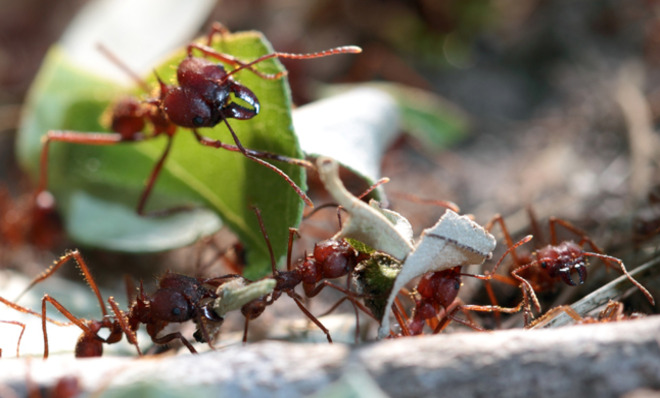Meet the sommelier of insect stings
A yellowjacket sting is "hot and smoky, almost irreverent. Imagine W.C. Fields extinguishing a cigar on your tongue."

As summer creeps in to my backyard, so does a deep fear that any one of the insects flitting about the patio might decide to land on a spot of exposed flesh and sink its stinger into me. The paranoia is so strong that I keep a shoe within arm's reach so I can swat at anything that flies, jumps, or crawls my way. And there's good reason for that.
"The thing about arthropod stings that makes them so scary is not just that they hurt — it's that they're actually designed to hurt," writes University of Illinois entomologist May Berenbaum. "Arthropod venom is a fiendish mixture of pharmacologically active substances that for the most part serve no function in the life of the organism producing them other than to inflict pain on other organisms."
Getting stung by an insect hurts, straight across the board. But does one sting hurt worse than another? There's probably no one who will answer with a more emphatic "yes" than Justin O. Schmidt. He's another entomologist, and has been studying insects — mostly those in the order hymenoptera, which includes bees, wasps, and ants — for decades. Work with enough stinging insects over the course of your lifetime, and you're bound to get stung a few times. Or a few hundred, as Schmidt has.
The Week
Escape your echo chamber. Get the facts behind the news, plus analysis from multiple perspectives.

Sign up for The Week's Free Newsletters
From our morning news briefing to a weekly Good News Newsletter, get the best of The Week delivered directly to your inbox.
From our morning news briefing to a weekly Good News Newsletter, get the best of The Week delivered directly to your inbox.
While some other researchers might seek out safer work ("Kittens are nice and soft, empirical study finds"), Schmidt decided to compare and quantify the stings he'd experienced in a 1983 paper (the methods section reads in part, "Painfulness of venoms to humans was evaluated subjectively, mainly by the authors, to natural stings."). Over the years, he expanded and elaborated on the "Schmidt Sting Pain Index" until, in 1990, it ranked the stings of 78 different hymenoptera species on a scale of 0 to 4.
In the original papers, the numerical ratings do most of the talking, and the few verbal descriptions are fairly straightforward. The sting of the Florida harvester ant, for example, is compared simply to the ripping of a muscle or tendon. As his work was introduced to a wider public audience, though, the descriptions of the different stings grew more colorful, almost sommelier-like. Just have a look at these excerpts from a 1996 Outside article, where Schmidt laid out some of the more notable stings:
Sweat bee: "Light and ephemeral, almost fruity. A tiny spark has singed a single hair on your arm." Pain Rating: 1
Fire ant: "Sharp, sudden, mildly alarming. Like walking across a shag carpet and reaching for the light switch." Pain Rating: 1.2
A free daily email with the biggest news stories of the day – and the best features from TheWeek.com
Bullhorn acacia ant: "A rare, piercing, elevated sort of pain. Someone has fired a staple into your cheek." Pain Rating: 1.8
Bald-faced hornet: "Rich, hearty, slightly crunchy. Similar to getting your hand mashed in a revolving door." Pain Rating: 2
Yellowjacket: "Hot and smoky, almost irreverent. Imagine W.C. Fields extinguishing a cigar on your tongue." Pain Rating: 2
Red harvester ant: "Bold and unrelenting. Somebody is using a drill to excavate your ingrown toenail." Pain Rating: 3
Southern paper wasp: "Caustic and burning, with a distinctly bitter aftertaste. Like spilling a beaker of hydrochloric acid on a paper cut." Pain Rating: 3
Pepsis wasp: "Blinding, fierce, shockingly electric. A running hair dyer has been dropped into your bubble bath." Pain Rating: 4
Bullet ant: "Pure, intense, brilliant pain. Like walking over flaming charcoal with a three-inch nail embedded in your heel. Pain Rating: 4+
As helpful and descriptive as it is, Schmidt's index has its limits. For one thing, there are limited data points — some of his species are rated based on a single sting. The rankings are also highly subjective and based on the experiences of Schmidt and a handful of colleagues. A guy who has been stung as many times as Schmidt has must be more tolerant of pain than most. A more empirical system could be developed, Schmidt told Zoologix with "a good assay technique to connect electrodes directly to pain transmitting nerves and relate the voltage values recorded to our sensation of pain level."
Exactly where you get stung can affect how painful it is, too. Earlier this year, grad student Michael Smith, who studies bee behavior at Cornell, ranked the painfulness of stings to different body parts by subjecting himself to multiple bee stings on 25 different areas of his body for 38 days straight. According to his self-experimentation, the three most painful places to get stung are the penis shaft, the upper lip, and the nostril, which he rated 7.3, 8.7 and 9.0, respectively, on a 1-10 scale. Smith describes the nostril sting as "electric and pulsating" and "especially violent, immediately inducing sneezing, tears, and a copious flow of mucus."
And of course, there are stinging critters outside of groups that Schmidt and Smith study. Bark scorpions are known for "intensely painful, potentially lethal stings" that victims describe as "like being branded, or burned with a cigarette, and then driving a nail in." (Going back to subjectivity, Schmidt says that he provoked a large bark scorpion into stinging him, and found it hurt less than a honeybee sting). Jellyfish stings are more like "fireballs in every fiber" of your muscles, says Australian endurance swimmer Chloe McCardel.
Stingers don't have the monopoly on ruining your day either; to hear what it's like to suffer a variety of different animal bites, head here.
-
 Film reviews: ‘Marty Supreme’ and ‘Is This Thing On?’
Film reviews: ‘Marty Supreme’ and ‘Is This Thing On?’Feature A born grifter chases his table tennis dreams and a dad turns to stand-up to fight off heartbreak
-
 Political cartoons for December 14
Political cartoons for December 14Cartoons Sunday's political cartoons include a new White House flag, Venezuela negotiations, and more
-
 Heavenly spectacle in the wilds of Canada
Heavenly spectacle in the wilds of CanadaThe Week Recommends ‘Mind-bending’ outpost for spotting animals – and the northern lights